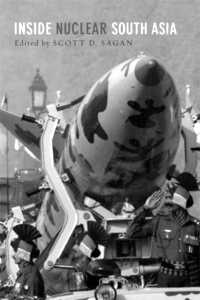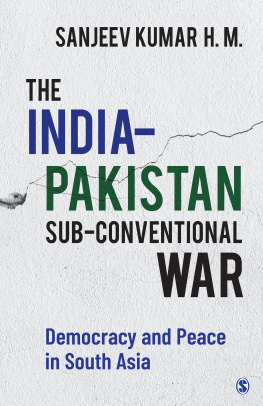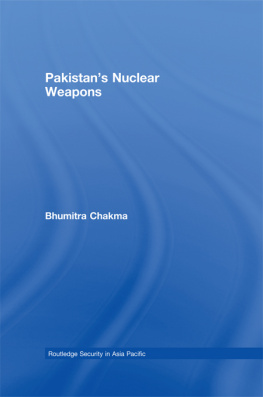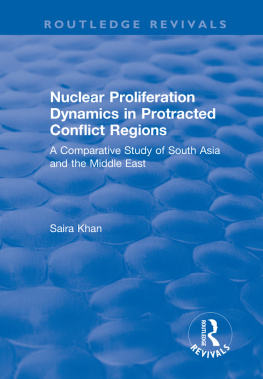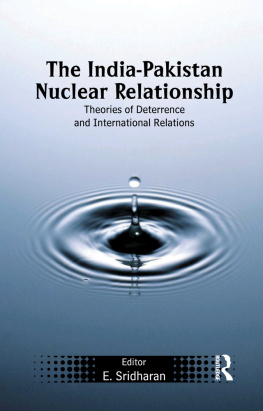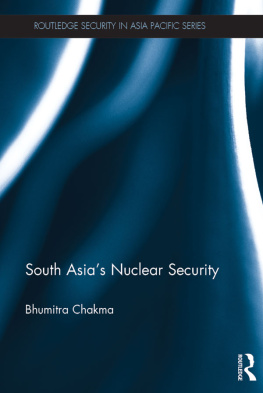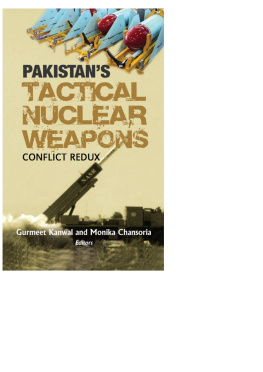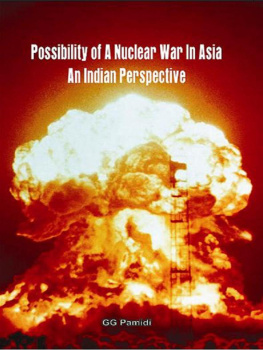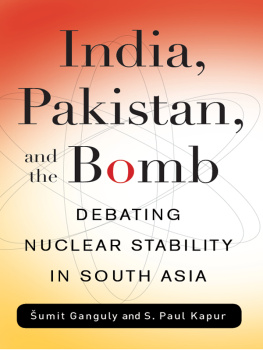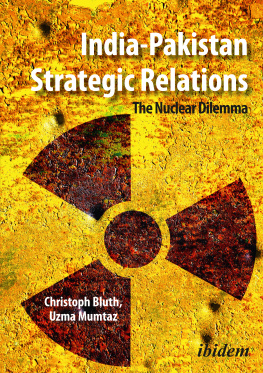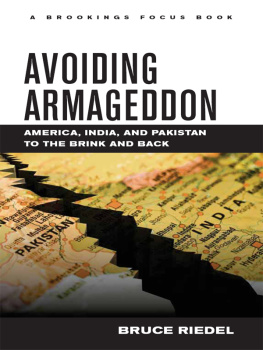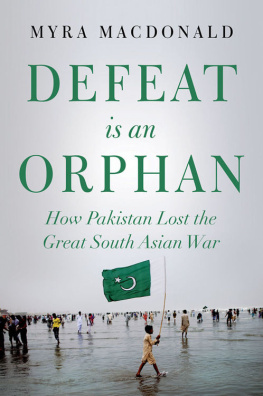Edited by Scott D. Sagan



vii
ix
Tables
2.1 Theoretical expectations and measures 73
2.2 Selected values on variables for Pakistan and India 78
2.3 Substantive effects of the explanatory variables on likelihood of pursuing and acquiring nuclear weapons 80
4.1 Events-data analysis for Pakistan's ballistic missile flight tests 152
4.2 Results of coding analysis for Pakistan's ballistic missile flight tests 154
4.3 Results from events-data analysis for Indian ballistic missile flight tests 159
4.4 Results of coding analysis for India's ballistic missile flight tests 161
6.1 Four theories in search of a doctrine 226
Figures
2.1 Predicted likelihood of acquiring nuclear weapons 81
2.2 The effect of enduring rivalry on the predicted likelihood of acquiring nuclear weapons 84
2.3 The effect of alliances with nuclear-armed powers on the predicted likelihood of acquiring nuclear weapons 86
2.4 Predicted likelihood of acquiring nuclear weapons with delayed crossing of industrial threshold 88
2.5 What if India and Pakistan had been Tigers? Fast-economicgrowth scenarios 89
2.6 High-economic-openness scenarios 90
4.1 Framework for South Asian strategic weapons decisions based on the nuclearization debate 144
4.2 Framework capturing South Asian strategic weapons dynamics 167
5.1 Strategic stability and subnuclear violence: Cold War Europe versus nuclear South Asia 194

I HAVE MANY PEOPLE TO THANK, in addition to my contributing authors, for their important roles in producing Inside Nuclear South Asia. First, and foremost, I must thank my colleagues at Stanford's Center for International Security and Cooperation (CISAC) for maintaining such a stimulating intellectual environment and for providing opportunities to present my own work, and the research of the other contributing authors, in the social science seminars at Stanford. Siegfried Hecker, Christopher Chyba, and Lynn Eden have shared directing responsibilities with me at CISAC during the years that this book was written, and I thank them for enabling me to focus, for at least some portion of my time, on my own research and writing. Second, I thank Rupal Mehta, Josh Weddle, Kate Hadley, Oriana Mastro, Michael Orgil, Natasha Pereira- Kamath, and David Robbins for their excellent research assistance. Third, I want to thank the Strategic Studies Institute at the U.S. Army War College and the Carnegie Corporation of New York for providing funds to support a conference in which many of the authors were able to try out their ideas and receive feedback from each other. Fourth, I want to thank my many colleagues and friends in India and Pakistan, from whom I have learned so much over the years and who have maintained a constant spirit of intellectual cooperation even when we disagreed about the effects of nuclear weapons on South Asian security. I especially want to express my gratitude to V. R. Raghavan and K. Shankar Bajpai for hosting me at many seminars at the Delhi Policy Group and to Jehangir Karamat for arranging my meetings in Lahore and Islamabad.
Finally, I thank my wife, Sujitpan Bao Lamsam, and my children, Benjamin, Charlotte, and Samuel, for accepting that I will occasionally fly off to distant parts of the world to conduct research and have been, even more often, distracted at home by the books and papers I am reading about nuclear proliferation. I hope that my children will someday inherit a safer and more just world. If my scholarly work and that of my coauthors contribute, even in a small way, toward those lofty goals, I trust that my children will feel that my time away from them has been well spent.
Scott D. Sagan




THERE IS AN OLD SAYING IN WASHINGTON THAT "politics ends at the water's edge." The sentiment behind this aphorism-that foreign policy and security policy should be bipartisan-has always been more of an ambition than a reality. But the saying is certainly accurate when describing both popular and scholarly knowledge of other countries' foreign and defense policy: our understanding of domestic politics too often ends at the water's edge. Policy makers and scholars find it easy to understand how conflicting domestic political interests and bureaucratic infighting can influence major foreign policy decisions-even decisions involving crucial national security issues like nuclear weapons policies-in their own countries. American analysts, for example, find it quite natural to focus on differences between Democratic and Republican administrations, and their ability to control shifting majorities in Congress, when examining support for national missile defense programs or to examine differences between the position of the secretary of state and the secretary of defense, and who has the president's ear, when explaining the U.S. stance in an international arms control negotiation. Yet when these same analysts focus on similar national security issues in other countries, they too often simply assume that decisions are made by a unitary rational actor and that objective national security interests, not competing domestic political parties or parochial bureaucratic interests, are the key determinant of policy choice.
Studies of nuclear weapons proliferation are particularly vulnerable to this kind of analytic bias. Sensitive policy decisions inside countries seeking to develop nuclear weapons are typically made in a highly secretive manner within tightly compartmentalized government decision-making bodies. Crucial documents, which might be available for scholarly review in other issue areas, are usually kept highly classified in the nuclear weapons arena. In addition, politicians who might be willing to discuss or even brag about the local interests behind their positions regarding a trade bill or new environmental legislation ironically have domestic political incentives to deny that domestic politics influence crucial national security decisions. It is considered far more legitimate and patriotic for leaders to take positions on nuclear weapons issues strictly based on the national interest, at least as they envision it. In political science, scholars who assume that states behave in a highly rational manner, responding to vital international security interests in an anarchical world, are called "realists" or "neorealists." Politicians in all nuclear countries have political motives for speaking like realists, stressing the necessity of responding to adversaries' threats in justifying their nuclear weapons policies to foreign or domestic audiences, rather than acknowledging that they have been influenced by domestic politics or other parochial concerns.' All politics are local, U.S. Congressman Tip O'Neill famously said. But all politics concerning national security issues are not supposed to be local; they are supposed to be designed solely to serve the national interest.

